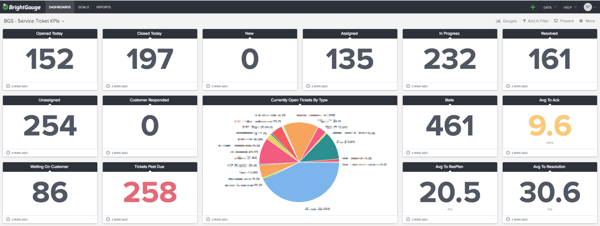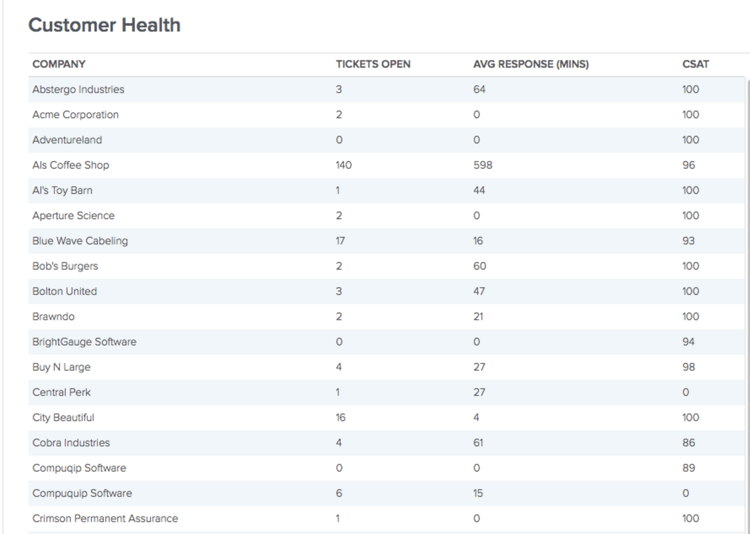How Smart MSPs Avoid Making Bad Decisions Caused by Metrics

Metrics are powerful tools for determining how successful you are in improving aspects of your business, but unfortunately, they can also lead you astray and cause you to make decisions that have a negative impact.
The most successful MSPs know this and have learned to take the following 4 steps in order to avoid making poor business decisions:
1. Start with a Goal
Which came first: The Metric or the Goal?
This is something that often stumps business owners, but it’s important to remember that metrics are used for measuring things, not setting goals.
A metric should be based on a goal, not the other way around.
Let’s look at an example:
Say your goal is to increase your profit. The top MSPs will create a set of 1-4 metrics (per goal) to measure whether they’re achieving success (which in this case would be increased profitability).
In this example, you’d want to use the following metrics:
- Operating Profit
- Cost of Goods
- Number of New Clients a Month
This step really is as simple as choosing metrics that measure how you’re reaching your goals, but you could still be making bad decisions if you haven’t completed all of the steps on this list.
2. Understand Vanity Metrics vs. Useful Metrics
One of the biggest reasons MSPs make poor decisions is because they are not familiar with the difference between vanity metrics and useful metrics.
What is a Vanity Metric?
Vanity metrics are metrics that sound good, and make you feel good, but don’t give clear information as to where your company stands. Here are some examples of vanity metrics with explanations:
- Website Traffic - While many, many companies track this metric, it doesn’t actually give you useful information. There could be any number of reasons your traffic increases or decreases!
- Followers on Social Media - This metric is similar to website traffic so you won’t know the reasons behind the increase or decrease - reasons that are (arguably) more important than the total number of followers.
- Email Open Rate - Besides telling you the effectiveness of your headline, your email open rate doesn’t really give you any actionable data. You won’t know how successful your email was until you dive into useful metrics like leads generated.
Vanity metrics aren’t useless, but they shouldn’t be the metrics you focus on.
What is a Useful Metric?
The SMART approach is one of the best ways to determine if a metric is useful or not. In case you aren’t familiar with SMART, it stands for Specific, Measurable, Attainable, Realistic and Timely.
A Specific metric is clearly defined and identified. You want to avoid broad metrics because they give little insight into what is causing changes in numbers.
Measurable metrics are quantifiable and not qualitative.
An Attainable metric is able to be obtained and measured easily by your whole team. You should also be able to create reports around these metrics easily.
Realistic metrics are practical, not theoretical.
A Timely metric can be tracked often, though the exact time frame depends on where it’s being used and how. Some metrics need to be tracked daily while others may only need a quarterly check. Either way, you need your data there in a timely manner.
Sometimes, a metric’s attainability and timeliness has less to do with the metric itself and more to do with the way you collect, organize, and share your data. For example, if you use a data dashboard you can easily create and share reports on any of the metrics you track!

3. Paint the Full Picture
The best MSPs understand that metrics can result in tunnel vision if not used correctly and they require care to truly know where your business stands.
Let’s say your goal is to increase client satisfaction. You decide to track the following Customer Health metrics:
- Customer happiness (measured with a SmileBack survey)
- Number of open support tickets
- Average time to first ticket response.
Over the course of 4 months, you see that your customer happiness increases, average number of open support tickets decreases and average time to first ticket response decreases. Great, your client satisfaction has increased, right? Wrong, and here’s why:
Even though your statistics told you that you were doing great, you didn’t get the whole picture and missed a larger, more severe problem.
If you had been also measuring your kill rate you would have seen that your technicians were struggling to handle a large volume of tickets in the last few months. Because of the high workload, some tickets were left unanswered or hastily resolved at best, causing your clients to leave for an MSP with better service.
Had you been measuring these metrics, you would have been able to avoid losing clients by hiring an extra technician to help with the large volume of tickets or upgrading your PSA. This is why it’s so important to have the full picture.
4. Avoid Metrics That Can Be Easily Manipulated
Another issue is metrics that can be manipulated and skewed to look better than they truly are.
Let’s use the same scenario as above, with your goal being to increase client satisfaction. You realize your mistake and start tracking the number of tickets being closed. In addition, you provide an incentive for technicians with the highest number of tickets closed.
The only problem now is that your technicians could create fake tickets and then resolve them in order to post higher numbers, and while this is uncommon and really more of an issue with the employee than the metric itself, it’s something you need to keep in mind when choosing which metrics to focus on.
Examples of Metrics that Smart MSPs Use
Here are some of the best metrics to track for MSPs:
- Client satisfaction
- Revenue
- Profit
- Churn rate
- Cost of goods sold
- Number of clients
- Number of new clients
- Average number of open tickets
- Average first response time
- Average time to ticket completion
- Number of tickets submitted by client
- Number of tickets resolved by technician
- Customer Satisfaction (CSAT)
Remember, not every MSP will track the same metrics, and you’ll figure out which are important to track when you follow the steps given above.
Key Takeaways
- Base your metrics on your goals, not the other way around.
- Track 1-4 metrics per goal and up to 20 total in order to avoid overwhelming your team and/or yourself.
- Avoid vanity metrics like the plague and only track those that are SMART.
- Use a dashboard to ensure you can easily track, organize and share your data.
- Ensure your metrics paint the full picture by avoiding tunnel vision and focusing on both broad and detailed metrics.
- Keep in mind that metrics can be manipulated and avoid them when possible.
To read more about metrics, download our free whitepaper Internal Metrics That Matter For MSPs.
Free MSA Template
Whether you’re planning your first managed services agreement, or you’re ready to overhaul your existing version, we've got you covered!




